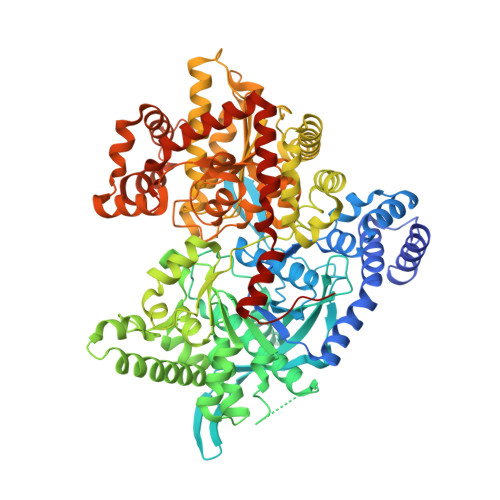Acyl ureas as human liver glycogen phosphorylase inhibitors for the treatment of type 2 diabetes.
Klabunde, T., Wendt, K.U., Kadereit, D., Brachvogel, V., Burger, H.J., Herling, A.W., Oikonomakos, N.G., Kosmopoulou, M.N., Schmoll, D., Sarubbi, E., von Roedern, E., Defossa, E.(2005) J Med Chem 48: 6178-6193
- PubMed: 16190745
- DOI: https://doi.org/10.1021/jm049034y
- Primary Citation of Related Structures:
2ATI - PubMed Abstract:
Using a focused screening approach, acyl ureas have been discovered as a new class of inhibitors of human liver glycogen phosphorylase (hlGPa). The X-ray structure of screening hit 1 (IC50 = 2 microM) in a complex with rabbit muscle glycogen phosphorylase b reveals that 1 binds at the AMP site, the main allosteric effector site of the dimeric enzyme. A first cycle of chemical optimization supported by X-ray structural data yielded derivative 21, which inhibited hlGPa with an IC50 of 23 +/- 1 nM, but showed only moderate cellular activity in isolated rat hepatocytes (IC50 = 6.2 microM). Further optimization was guided by (i) a 3D pharmacophore model that was derived from a training set of 24 compounds and revealed the key chemical features for the biological activity and (ii) the 1.9 angstroms crystal structure of 21 in complex with hlGPa. A second set of compounds was synthesized and led to 42 with improved cellular activity (hlGPa IC50 = 53 +/- 1 nM; hepatocyte IC50 = 380 nM). Administration of 42 to anaesthetized Wistar rats caused a significant reduction of the glucagon-induced hyperglycemic peak. These findings are consistent with the inhibition of hepatic glycogenolysis and support the use of acyl ureas for the treatment of type 2 diabetes.
- Sanofi-Aventis Deutschland GmbH, Scientific and Medical Affairs, D-65926 Frankfurt am Main, Germany.
Organizational Affiliation:



















